Betty White: art sanctifies the universal experience

If an artist decides that her unconscious mind and feelings should direct her work, should she also conclude that the artistic success of the piece she has created and that of her whole body of work depend on how much of her deep self is revealed and how easily her work is understood?
Carl Jung the great psychoanalyst and interpreter of anthropological symbolism said, “The secret of artistic creation and the effectiveness of art is to be found in a return to the state of ‘participation mystique’, to that level of experience at which it is man who lives and not the individual.” Such is the world view of Cabbagetown artist Betty White, who successfully documents her life’s landmarks in personal, accessible and moving works of art.
Entering her work space, I am surrounded by shells, tied sticks, stones and pieces of nature, full yet organized tables of pastels, papers, books and musical instruments, cabinets of curio and treasures. I know I am walking into a specific mind set; the outward manifestation of the inner creativity of Betty White.
A work in progress, pinned to the studio wall attracts me, while other powerful works hang in frames along the hall. The large works on paper consist of sculpted pressed paper pieces; images in pastels, pencil and other media. Each handsomely framed piece in Betty’s hallway gallery seems to represent a specific chapter of her experience; a visual Book of Hours. The sculptures; wrapped or tied pieces in small archaic looking figurative shapes, suggest a child bound to a mother, or perhaps a shaman — as the rock itself — nature-crafted, artist-made talismans of an unconscious longing.
Born in Worcester Massachusetts in 1944 into a family of accomplished musicians and scholars and having achieved her Bachelor of Arts degree in 1966 from The University of Colorado, White began her career as apprentice to Olly Reinheimer, the prodigious Brazilian fibre artist in Rio de Janeiro.
She enhanced her skills as a textile artist by taking paper-making workshops in Montreal and at the Ontario College of Art & Design in Toronto. She taught at The Canadian Guild of Crafts in Montreal and The School House in Toronto and ran a paper making course for teachers at The Children’s Museum in Boston.
Senior art teacher at The Montcrest School in Riverdale, Betty White lives her art and comments; “I plug into a sort of ‘archetypal’ imagery that makes sense; my own creative visual language. I know a piece is finished when it’s original, natural and emotionally true.” Thus White names herself Modern Primitive… “someone who somehow carries in her bloodstream, the echoes of a distant past.”
The word “archetype” appeared in European texts as early as 1545, derived from the Latin noun archetypum after the Greek noun arkhetypon.
It means simply, “first-moulded.” Archetypes have long been present in mythologies from classical literature, such as epic myths to modern re-workings of fairy tales. The use of archetypal symbols to understand human personalities was developed as an aspect of analytical psychology by Carl Jung in the early 20th century.
The benefit of these archetypes, whether depicted in drama, fiction or art, is obvious when themes of character, motivation or image are recognized easily by viewers. Each artist may develop an acute understanding of her/his work through analysis or through making art. Alternatively artists may remain unaware of their own inner workings yet continue to generate a lifetime’s output, such as some of the naive or primitive artists.
The universal experience of family life, music and awareness of death, filtered through the artist’s specific understanding and particular use of materials, attracts, and then snares the viewer.

Said White, “My experience with loss was the beginning of a lot of what was to come. I was well established as an artist and then lost my first child. lhe experience changed me profoundly. I understood how short life is and my ‘emergency’ magnified and intensified my experience of life. I loved every exquisite moment of being alive. It also accelerated and intensified my experience of art-making and I processed this through my artwork for many years. Initially my work was motivated by childhood memories and poetry, which I adore. Be it a poem, novel or good opera, they all contain the element that cuts across and touches you deeply.”
Her love of music is evident in the exploration of a poem regarding The Viola D’amore; by Irish poet, Moya Canon. Betty’s connection to dream states and her womanly expression or powerful and resonant ideas, is depicted in “The Mother, The Child” seen here, where the cello body becomes that of the mother — woman as vessel.
White’s work has been in demand over the many years of her career.
She has exhibited in France, Mexico, Toronto, Martha’s Vineyard and Boston and her work is in the collections of Readers Digest, The Canada Council, the Art Bank and private collections.